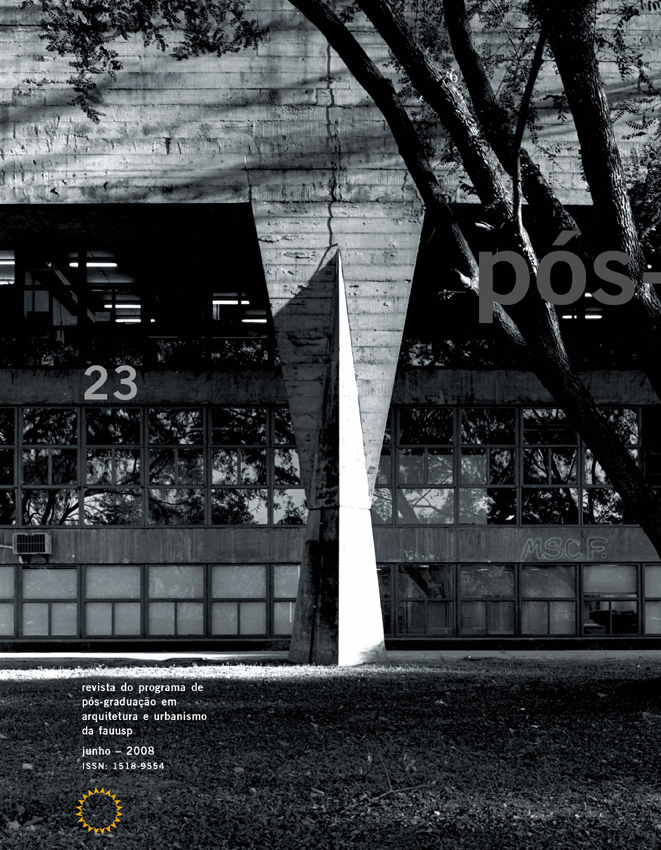Directional analysis of são paulo metropolitan region urban growing (1905-2001), using fractal dimension
DOI:
https://doi.org/10.11606/issn.2317-2762.v0i23p100-118Keywords:
Fractal dimension, urban agglomeration, São Paulo metropolitan area, urban expansion, space analysisAbstract
The objective of this study is to analyze the growing process of São Paulo metropolitan area urban agglomeration, from 1905 to 2001. Fractal analysis was used to identify factors that influenced the urban shape, spatial distribution of structures and the density of the occupation in the urbanized areas. This study was accomplished to thematic maps and orbital images. Using the association between concentric circles and cell count methods, the fractal dimension was measured to yield occupational density (Dd) of the urban areas. Urban agglomeration showed means values of Dd = 1.755 - which reflect a non-homogeneity in the filling pattern of the density from central to peripheral circle of urban space. Mean fractal dimension of urban radial growing was calculated to eight urban radial sectors as following: (I) Cantareira=1.829; (II) East Zone=1.898; (III) Mauá=1.848; (IV) Ipiranga=1.852; (V) Billings=1.858; (VI) Santo Amaro/Interlagos=1.848; (VII) Castelo Branco/Anhangüera=1.859; and (VIII) Anhangüera/Bandeirantes=1.863. Among determinants factors on fractal behavior of the sectors I, III, IV, V, VI e VIII, the topographical, hydrographical and environment-legal constraints did influence on fragmented occupation; and for sectors II, III, IV, VI e VII the high density of the occupation was supported by the public incentives on industrial, business and road development.Downloads
References
BATTY, M; LONGLEY, P. Fractal cites. São Diego: Academic Press Inc., 1994.
BATTY, M; LONGLEY, P.; FOTHERINGHAM, A. S. Urban growth and form: Scaling, fractal geometry, and diffusion-limited aggregation. Environment and Planning, v. 21, p. 1.447-1.472, 1989.
CARLOS, A. F. A. A (re)produção do espaço urbano. São Paulo: Edusp, 1994.
CARTER, H. El estudio de la geografia urbana. 2 ed. Madri: Faresco, 1987.
CASTELLS, M. La question urbana. Cidade do México: Siglo Veintruno, 1976. DE COLA, L.; LAM, N. S. Fractals in geography. Nova Jersey: Prentice Hall, 1993.
EASTMAN, J. R. IDRISI32. Worcester, Massachusetts: Clark University, 1999. Licença nº1456 (Pósgraduação em Geografia).
EMPLASA (Estado). Secretaria de Negócios Metropolitanos. Plano metropolitano da Grande São Paulo 1994/2010. São Paulo: Emplasa, 1994.
FRANKHAUSER, P. La fractalité des structures urbaines. Paris: Anthropos, 1994.
GARNER, B. J. Modelo de geografia urbana e localização de povoações. In: CHORLEY, R. J. Modelos integrados em geografia. Rio de Janeiro: USP, 1975.
GOODCHILD, M. Fractals and the accuracy of geographical measures. Journal of the International Association for Mathematical Geology, Nova York: Plenum Publishing Corporation, v. 12, n. 2, p. 85- 98, 1980.
GOODCHILD, M. F.; MARK, D. M. The fractal nature of geographic phenomeno. Annals of the Association of Ameriacan Geographers. Washington: Association of American Geographers, v. 77, n. 2, p. 265-278, 1987.
IBGE – Instituto Brasileiro de Geografia e Estatística. Censo demográfico. Rio de Janeiro: IBGE, 1991. KIVELL, P. Land and the city: Patterns and processes of urban change. Londres/Nova York: Routledge, 1993.
KLINKENBERG, B.; GOODCHILD, M. F. The fractal proprieties of topography: A comparison of methods. Earth surface processes and landforms. Nova York: John Wiley & Sons, v. 17, p. 217-234, 1992.
LONGLEY, P.; MESEV, V. On the measurement and generalization of urban form. Center for Advanced Spatial Analysis. Londres: Copyright CASA, UCL, 2000. WorKing Paper Series.
SANTOS, M. A urbanização brasileira. São Paulo: HUCITEC, 1983.
SÃO PAULO (Cidade). A cidade, o habitante e a administração: 1975-1979. São Paulo: Brasiliense, 1979.
TORRENS, P. M. Can geocomputation save urban simulation throw some agents into the mixture, simmer, and wait... Center for Advanced Spatial Analysis. Londres, paper 32, 2001. WorKing Paper Series.
UNWIN, D. Fractals and the geosciences: Introduction. Computers & Geosciences. Oxford: Pergamon Press, v. 15, n. 2, p. 163-165, 1989.
VILLAÇA, F. A estrutura territorial da metrópole sul brasileira. São Paulo: USP-FFLCH (Departamento de Geografia), 1978.
XU, T.; MOORE, I. D.; GALLANT, J. C. Fractals, fractal dimensions and landscapes – A review. Geomorphology. Amsterdã: Elsevier Science Publishers B. V., v. 8, p. 245-262, 1993.
Downloads
Published
Issue
Section
License

This work is licensed under a Creative Commons Attribution 4.0 International License.
DIADORIM - Diretório de Políticas Editoriais












